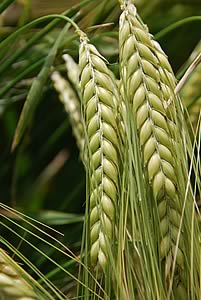 |
|||||||||
|
|||||||||||||||||||
FAO
Publishes Study on Marker-Assisted Selection The biotechnology tool of marker-assisted selection (MAS) has raised high expectations for increasing genetic progress through breeding. Some experts have even argued that the application of MAS could “revolutionize” the way varieties and breeding stock are developed.
In a new comprehensive assessment (Marker-Assisted Selection, Rome 2007), FAO emphasizes that MAS has enormous potential but notes that the technology has not yet delivered its expected benefits to farmers in developing countries. Shivaji Pandey, Chairperson of the FAO Working Group on Biotechnology, gives his view on MAS. What is marker-assisted selection (MAS)? MAS is a biotechnology tool that could greatly accelerate conventional breeding of crops, livestock, farmed fish and trees. Scientists are using MAS to genetically improve certain characteristics or traits (productivity, disease resistance, quality etc.) that are important for farmers. MAS makes it possible to select traits with greater accuracy and to develop a new variety quicker than in the past. What is the difference between MAS and genetically modified organisms (GMOs)? MAS and genetic modification are different biotechnologies. MAS allows desirable genes to be "marked" or tagged so they can be selected within the breeding population, while GMOs are the result of the transfer of a desirable gene or genes from one species to another. New plant varieties or improved animal breeds resulting from MAS do not require a specific legislative framework. The complicated approval process required for GMOs does not apply for MAS - its costs of release are therefore lower. In addition, the technology is not controversial so there is no problem with public acceptance. Indeed, one of the drawbacks of the intense debate that has taken place in recent years over the benefits and risks of GMOs is that it has overshadowed the potential role that other, non-GMO, biotechnologies, such as MAS, may play for food and agriculture. What is the potential of MAS? Since MAS first became a practical reality about 20 years ago, it has now gone past the research and development stage and is being applied in the field. For example, it is currently being used in dairy cattle breeding programmes in France and Germany, and rice varieties with improved bacterial blight resistance have being developed using MAS approaches and released in India and Indonesia. However, initial enthusiasm and optimism have been tempered by the realization that it is more difficult and takes longer than originally thought before genetic improvement of traits using MAS can be realized. The considerable resources invested in this technology have been mainly concentrated in the industrialized world, and MAS has not yet delivered its expected benefits to farmers in developing countries. What are the costs associated with MAS? MAS requires quite a sophisticated infrastructure and considerable investments: including specialized equipment, electricity, laboratory design and management, data handling and statistics, and Internet connectivity. Efficient and effective application of MAS also requires well-qualified staff and good funding. It should therefore be used where there is a clear advantage over traditional selection techniques. What are the constraints countries are facing applying MAS? Apart from the investments required, a serious constraint that most countries face in applying MAS is the lack of a national policy on science and technology and on biotechnology. This is essential to provide guidance on the strategic planning, monitoring and evaluation of biotechnologies, including MAS, for food and agriculture. In addition, MAS should only be applied when well-structured breeding programmes are already in place, which is often not the case in many developing countries. How could the application of MAS contribute to hunger and poverty reduction? Most of the around 820 million hungry people in developing countries live in rural areas where people’s livelihoods depend on agriculture. This means that investing in agriculture, and more broadly in rural development, must be at the heart of any strategy for hunger and poverty reduction. While the measures needed certainly go well beyond the issue of producing more food and agricultural products, achieving greater yields and higher value products from the same plot of land or enterprise, through, for example, appropriate application of technologies such as MAS, must be a key ingredient for the great majority of developing countries.
|
|||||||||||||||||||

|
|
||||||||||||||||||
| home | agri-services | pedigree
pen | news | dairy | beef | machinery property | organisations | site map |
|||||||||||||||||||

